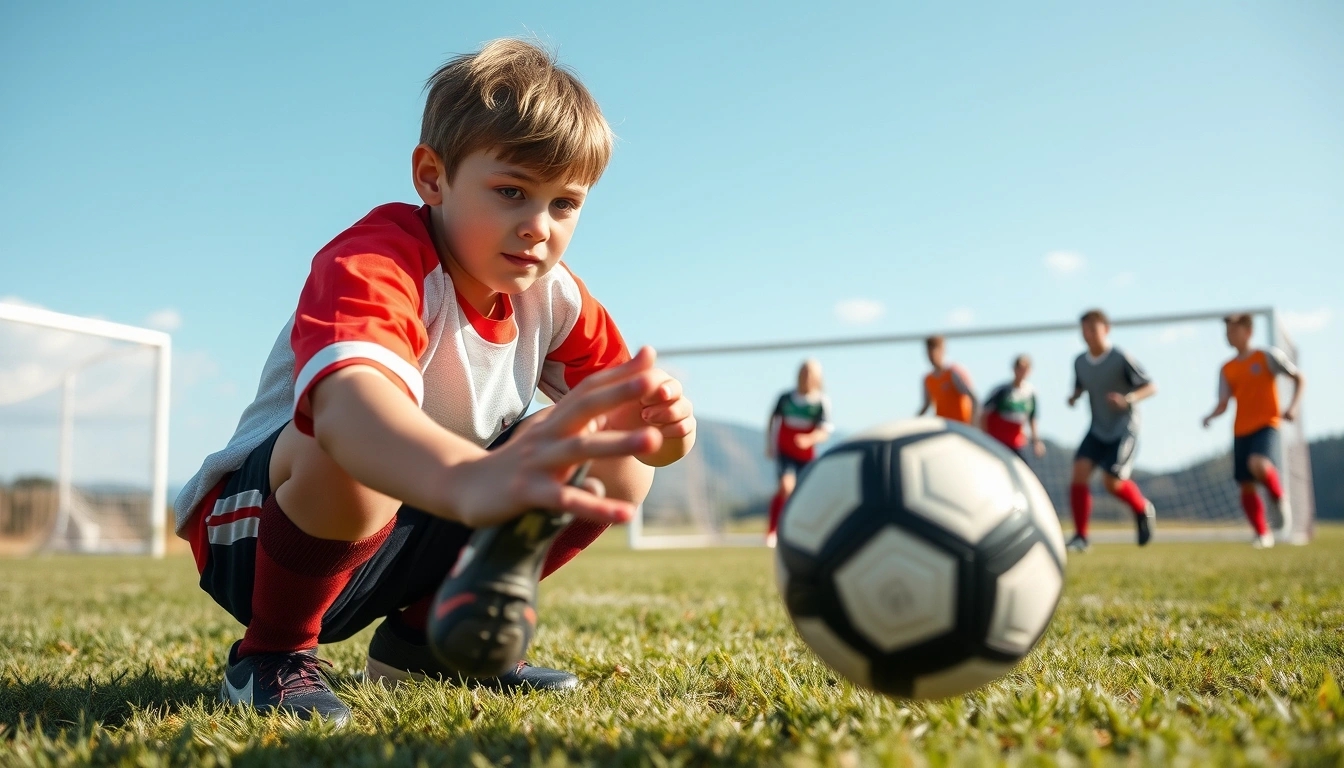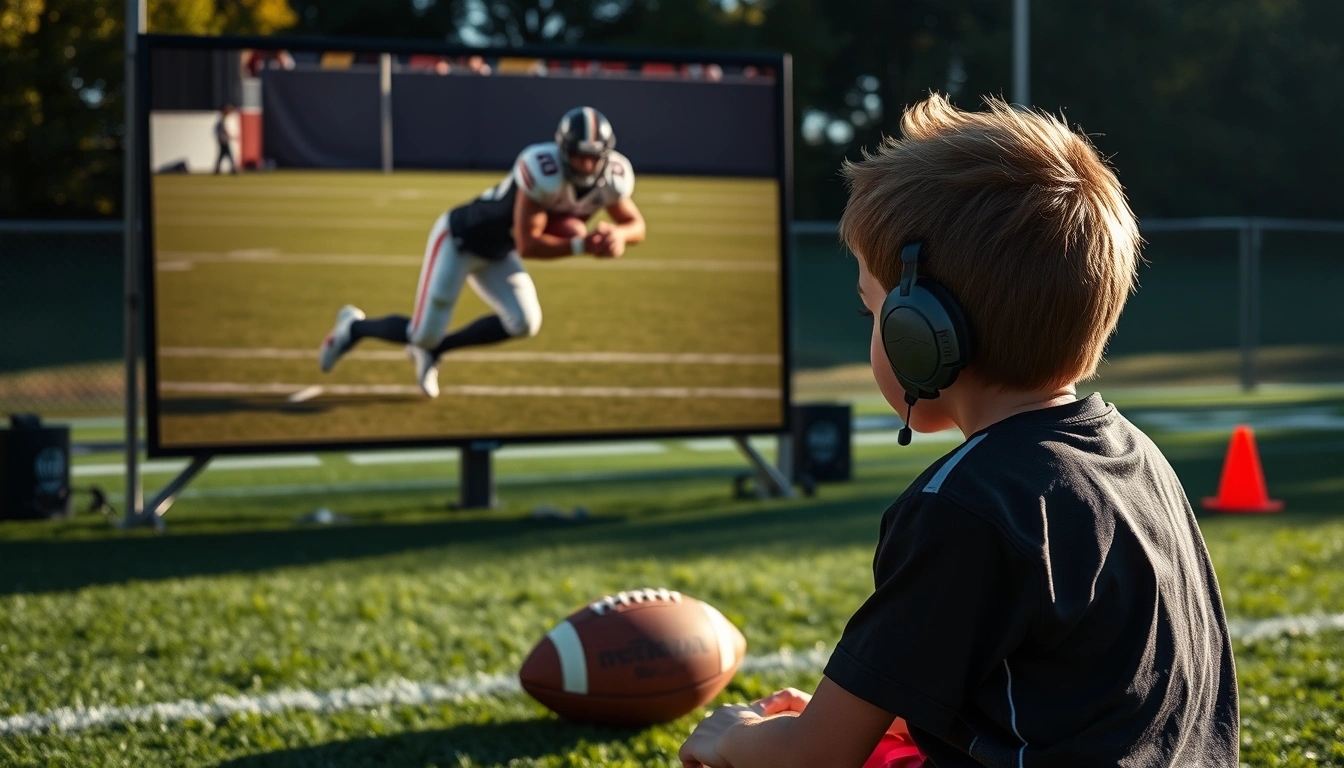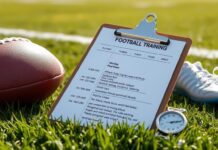Getting started with defending in football can feel like trying to solve a Rubik’s cube blindfolded — confusing, frustrating, and sometimes downright impossible. But here’s the kicker: if you want to be the kind of player who stops goals and makes your team proud, you’ve got to nail the basics first. Defending isn’t just about smashing into opponents or throwing yourself at the ball like a maniac; it’s about smart moves, patience, and yes, a bit of grit.
Understanding the Role of a Defender
Before you rush into tackles and blocks, take a moment to understand what defenders really do. Think of them as the team’s backbone — they’re the last line before the goalkeeper and the first line of attack when the ball turns over. Their job? Stop the other team from scoring and help the team keep control. Sounds simple, but it’s a bit like herding cats when the ball and players are zipping all over the pitch.
| Defender’s Key Responsibilities | Why It Matters |
|---|---|
| Marking Opponents Closely | Limits the attacker’s space and options |
| Intercepting Passes | Stops attacks before they start |
| Clearing the Ball Safely | Relieves pressure on the defense |
| Communicating with Teammates | Keeps the defense organized and alert |
Positioning: Where to Stand and Why
Now, here’s where many newbies trip up — standing in the wrong spot. Positioning is half the battle won, seriously. If you’re out of place, you’re basically giving the attackers a free pass. The trick? Stay between the goal and the attacker, keep your eyes on the ball, and anticipate where the play’s going next. Easier said than done, right? But practice makes perfect.
- Stay goal-side: Always position yourself closer to your goal than the attacker.
- Keep low and balanced: This helps you react quickly.
- Use your body smartly: Block passing lanes without fouling.
Basic Defensive Techniques Every Kid Should Know
Alright, let’s get practical. Techniques like jockeying — which is basically shadowing the attacker without diving in — are gold for beginners. Tackling? Sure, but timing is everything. Jump in too early, and you’ll concede a foul faster than you can say “offside.” Plus, no one wants to be that clumsy player who’s always on the floor.
Simple Defensive Drill:1. Pair up with a teammate.2. One tries to dribble past, the other practices jockeying.3. Switch roles after a few minutes.4. Focus on staying balanced and not lunging.
The Art of Tackling: Timing and Safety
Tackling isn’t a WWE match. It’s about patience and precision. Wait for the right moment when the attacker’s foot is on the ball, then make your move. And hey, safety first — no reckless challenges that end in injuries or red cards. Remember, a good tackle wins praise; a bad one gets you benched.
Communication: Talking Your Way to Better Defense
Defending is a team sport, no lone wolves here. Shouting “man on!” or “switch!” might sound annoying, but it’s crucial. Good communication can stop a goal before it even starts. So, don’t be shy—use your voice.
Common Mistakes New Defenders Make
Everyone screws up. But if you know the usual blunders, you can dodge them like a pro:
- Diving in too early and missing the ball.
- Getting caught ball-watching and losing your mark.
- Overcommitting and leaving gaps behind.
Drills and Exercises to Improve Defensive Skills
Practice is your best friend. Drills like shadowing, 1v1 defending, and reaction games sharpen your instincts and boost confidence.
| Drill | Purpose | How to Do It |
|---|---|---|
| Shadowing Drill | Improve positioning and patience | Follow your partner’s movements without tackling |
| 1v1 Defending | Practice tackling and jockeying | Defender tries to stop attacker from scoring |
| Reaction Games | Enhance quick decision-making | Coach calls out moves, defender reacts instantly |
How to Stay Motivated When Defending Gets Tough
Let’s be real — defending can be a grind. You’ll get beat, frustrated, and maybe even want to give up. But stick with it! Remember, every great defender started just like you: clueless and clumsy. Celebrate small wins, watch your progress, and keep pushing.
Watching and Learning: Using Pro Defenders as Role Models
Want some inspiration? Watch defenders like Virgil van Dijk or Lucy Bronze. Notice how calm they stay, how they position themselves, and how they communicate. You don’t have to be perfect, but learning from the best can give you ideas and boost your game.
In the end, defending is a mix of brains, bravery, and a bit of stubbornness. So, lace up, get out there, and don’t be afraid to make mistakes — that’s how you grow.
Understanding the Role of a Defender
Alright, before you rush headfirst into tackles and blocks like a bull in a china shop, it’s super important to get what defenders actually *do* on the pitch. Because, let’s be honest, if you don’t know your role, you might as well be chasing shadows out there. Defenders are the backbone of any football team — without them, your goalkeeper would be busier than a bee in a flower shop, trying to stop shots left, right, and center.
So, what’s the big deal with defenders? Simply put, they’re the team’s first line of defense against the opposition’s attacks. Their job isn’t just to kick the ball away or throw themselves at the attacker like it’s a WWE match. Nope, it’s about reading the game, anticipating where the danger will come from, and positioning themselves smartly to shut down threats before they even get close to goal.
- Stopping attacks: Defenders track and mark opposing players, making sure they don’t get comfortable or find space to shoot.
- Clearing danger: When the ball is in a risky spot, defenders clear it safely away from their goal area.
- Building play: In modern football, defenders aren’t just destroyers; they start attacks by passing the ball out of defense and helping the team move forward.
Now, here’s a little secret: being a defender isn’t just about muscle and tackles. It’s about brains too. You gotta be alert, think two steps ahead, and sometimes play the waiting game — patience is key. Imagine you’re a chess player, and every move counts. Rush in too soon, and you get beaten; hang back too long, and the attacker’s through on goal.
| Defender’s Key Responsibilities | Why It Matters |
|---|---|
| Marking Opponents | Prevents attackers from getting free shots or passes. |
| Intercepting Passes | Stops the opponent’s attacks before they develop. |
| Winning Tackles | Regains possession and stops dangerous plays. |
| Communicating with Teammates | Keeps the defensive line organized and alert. |
And let’s not forget, defenders often have to deal with some pretty frustrating moments — like when an attacker fakes left and darts right, leaving you grasping at thin air. But that’s part of the game. The best defenders learn from these slip-ups and come back smarter. It’s a tough gig, but someone’s gotta do it.
So next time you see a defender calmly shepherding an attacker away from goal or making a crucial interception, give them a nod of respect. They might not get the glory of scoring a last-minute winner, but without their grit and smarts, your team’s chances of winning would be slimmer than a toothpick.
In short, defenders are the unsung heroes who keep the chaos at bay. They’re the quiet warriors, the tactical brains, and the physical shields all rolled into one. Mastering their role means understanding that defense isn’t just about stopping goals — it’s about stopping problems before they start. And that, my friend, is what makes football such a beautiful game.
Positioning: Where to Stand and Why
Positioning: Where to Stand and Why
Okay, so here’s the deal — positioning in football is like half the battle won. Seriously, if you’re standing in the right spot, you’re already making life harder for the attackers. It’s not just about chasing the ball like a headless chicken; it’s about thinking ahead, anticipating moves, and being a wall your team can rely on. For kids and new footballers, this might sound like rocket science, but let’s break it down and make it simple.
First off, imagine the pitch as a giant chessboard. Your job as a defender isn’t just to follow the ball but to cut off passing lanes and block attackers’ options. Standing too close to the striker? You might get beaten by a quick feint. Too far? You’re basically inviting them to stroll past you. The sweet spot is somewhere in between — close enough to pressure, but not so close you get left in the dust.
| Position | Where to Stand | Why |
|---|---|---|
| Central Defender | Just in front of the goalkeeper, slightly towards the ball side | To intercept passes, block shots, and clear crosses |
| Fullback | Near the touchline, tracking wingers | To stop crosses and support midfielders |
| Defensive Midfielder | In front of the defenders, covering passing lanes | To break up attacks before they reach the backline |
Now, here’s a nugget of wisdom: always keep an eye on both the ball and your mark. Sounds obvious, right? But you’d be surprised how many defenders get tunnel vision and forget someone’s sneaking behind them. The best defenders have this crazy awareness — they know where the ball is, where their opponent is, and where their teammates are, all at once. It’s like having eyes in the back of your head.
- Stay goal-side: Always position yourself between the attacker and your goal. It means if they try to run at you, you’re the last obstacle.
- Keep your distance: Not too close to get beaten, not too far to lose control.
- Adjust constantly: The game’s moving fast, so your position should too.
Here’s a quick scenario to chew on: The opponent’s winger is sprinting down the flank, ready to whip in a cross. As a fullback, if you’re too far back, the winger has all the time and space to pick their spot. Too far forward, and they can dribble past you. The trick is to angle your run so you push them towards the sideline — that’s the defender’s best friend, the invisible boundary that limits options.
And hey, don’t forget teamwork. Positioning isn’t just about you standing still like a statue. It’s about working with your teammates — covering for each other, switching marks, and closing gaps. If your partner steps up to challenge, you drop back to cover. It’s a dance, not a solo act.
Tips for Better Positioning:- Keep your knees bent and be ready to move- Watch the player’s hips, not the ball — hips don’t lie!- Communicate constantly with teammates (“I got this!”, “Cover left!”)
In short, nailing positioning means you’re thinking smarter, not harder. You’re not just reacting; you’re predicting. And trust me, once you get this right, you’ll see how much easier defending becomes — and how much more your coaches will love you for it.
Remember: Positioning is the secret sauce of defense. Get it right, and you’re already halfway to stopping those pesky attackers in their tracks.

Basic Defensive Techniques Every Kid Should Know
Getting started with defending in football can feel like stepping into a whirlwind. There’s so much happening, and young players often get tangled up trying to do everything at once. But here’s the kicker: defending doesn’t have to be rocket science! It’s all about learning a few fundamental skills that, when practiced regularly, build up confidence and effectiveness on the pitch. Let’s break down some of these key techniques that kids can practice without feeling overwhelmed.
1. Jockeying: The Art of Staying in Control
Jockeying might sound fancy, but it’s basically about keeping your opponent in front of you without diving in too soon. Imagine you’re a cat stalking a mouse—slow, patient, ready to pounce but not rushing. This technique helps young defenders delay attackers, forcing them to make mistakes or wait for support. The secret? Stay low, keep your knees bent, and shuffle sideways while watching the ball, not the player’s feet.
2. Positioning: Your Defensive GPS
Where you stand can make or break a defense. Kids should learn to position themselves between the attacker and the goal, effectively acting as a human wall. It’s not about chasing the ball all over; it’s about anticipating where the attacker wants to go and cutting off those paths.
| Positioning Tips | Why It Matters |
|---|---|
| Stay goal-side of the attacker | Blocks their direct route to scoring |
| Keep a balanced stance | Ready to move in any direction quickly |
| Watch the ball, not just the player | Predicts next move better |
3. Tackling: Timing is Everything
Tackling might seem like the “cool” part of defending, but it’s actually a bit of a minefield for beginners. Jump in too early, and you’ll either miss the ball or, worse, give a foul. The key is patience and timing. Kids should practice waiting for the perfect moment when the ball is just a little too far from the attacker’s control and then swoop in cleanly with their foot.
- Side tackle: Approach from the side to avoid fouling.
- Block tackle: Use your body and foot to block the ball’s path.
- Slide tackle: Save this one for experienced players—timing is critical!
4. Intercepting Passes: The Sneaky Defender’s Trick
Intercepting is like reading a book before the attacker even turns the page. Kids can learn to watch the passer’s body language and the ball’s trajectory to jump in and take control. It’s a great way to turn defense into attack quickly.
Practice Makes Perfect
Here’s a quick drill table to help young defenders get these basics down:
| Drill | Focus | How to Practice |
|---|---|---|
| Jockeying shuffle | Staying balanced and patient | Partner dribbles slowly; defender shuffles sideways keeping distance |
| Positioning shadow | Learning to stay goal-side | Defender mirrors attacker’s movements without ball |
| Tackle timing | Perfecting clean tackles | Coach rolls ball to attacker; defender practices timed tackles |
| Interception game | Reading passes | Small-sided game focusing on cutting off passes |
To wrap it all up, kids should remember that defending isn’t about being the biggest or the fastest. It’s about smarts, patience, and practice. So, take it step by step, don’t rush into tackles like a bull in a china shop, and soon enough, those simple techniques will become second nature. Defending might seem tough at first, but with a bit of grit and a lot of practice, young players can become the backbone of their team’s success.
The Art of Tackling: Timing and Safety
Tackling in football isn’t just about barging into an opponent like a runaway train. Far from it! It’s a delicate dance of timing, control, and smarts — and if you get it wrong, well, you might end up gifting the other team a free kick or worse, a penalty. For young players especially, tackling can seem like a scary, high-risk move. But with the right approach, it becomes one of the most effective tools in your defensive toolbox.
First things first: timing is everything. Jumping in too early? You’re probably going to miss the ball and get called for a foul. Too late? The attacker’s already past you, and you’re left chasing shadows. The sweet spot is about reading the game, watching the ball, and waiting for that perfect moment when the opponent’s control slips or their next touch is predictable.
- Watch the ball, not the player’s feet. It’s tempting to focus on the player, but the ball tells the real story.
- Stay on your feet as long as possible. Sliding tackles look flashy but can be risky if mistimed.
- Use your body wisely. Shield the ball, nudge the opponent off-balance, and create space without fouling.
It’s also about safety — for both you and the person you’re tackling. Reckless tackles can cause injuries, and refs are quick to slap down yellow or red cards. So, always aim to tackle the ball cleanly. Avoid studs-up challenges or lunging wildly; they’re not only dangerous but also a quick way to get benched.
| Mistake | Why It Happens | Quick Fix |
|---|---|---|
| Diving in too early | Impatience or poor reading of the game | Practice patience; focus on watching the ball, not rushing |
| Missing the ball and fouling | Poor timing or over-aggression | Work on timing drills and controlled tackles |
| Sliding recklessly | Trying to impress or desperation | Learn when to slide and when to stand your ground |
Now, if you’re thinking tackling is all about brute force, think again. It’s more like a chess match — you’re anticipating moves, setting traps, and waiting for that golden chance to swoop in. And remember, sometimes the best tackle is the one you don’t make. Positioning yourself well to block passing lanes or force the attacker wide can be just as effective.
Here’s a quick drill to get your timing right:
1. Partner passes the ball slowly towards you.2. You move in with a gentle poke tackle to win possession.3. Gradually increase speed as you get comfortable.4. Focus on clean contact with the ball, not the player.
In the end, tackling is about respect — respect for the game, your opponents, and yourself. Nail the timing, keep it safe, and you’ll not only stop attackers but also earn the respect of teammates and fans alike. So, next time you’re out there, don’t just charge in like a bull; be the smart, precise defender every team wishes for.
Remember: It’s not about how hard you hit, but how well you hit the moment.
Communication: Talking Your Way to Better Defense
Defending in football? Oh, it’s definitely not a one-man show. If you think you can just stand there, hope for the best, and magically stop attackers all by yourself, well, you’re in for a rude awakening. The truth is, defense thrives on communication. It’s like a secret weapon that turns a group of individuals into a solid, unbreakable wall. But why is shouting, signaling, and working with your teammates such a big deal? Let’s dive in.
First off, imagine a defender standing still, eyes glued to the ball, but never saying a word. Confusing, right? The pitch can be chaotic — attackers darting left and right, midfielders pressing, and goalkeepers barking orders. Without clear communication, defenders often get caught out of position or miss crucial cover. Shouting commands like “Mark up!”, “Switch!”, or “Clear!” might sound basic, but it’s the lifeblood of organized defense. It alerts your teammates about threats they might not see and helps coordinate your movements.
- Why shout? Because the noise on the pitch is insane — fans, whistles, and the thump of the ball. Your voice cuts through all that chaos.
- Signaling matters too. A quick hand wave or pointing can guide teammates without wasting precious seconds.
- Trust your teammates. Defense is a team sport, and you’ve got to trust others to cover their zones if you’re stepping up.
Now, let’s talk about the magic of teamwork. Defenders who communicate well don’t just react; they anticipate. They know when to press, when to drop back, and when to double-team an attacker. This kind of synergy reduces mistakes like leaving players unmarked or getting caught flat-footed.
| Communication Method | Purpose | Example |
|---|---|---|
| Verbal Shouting | Alert teammates to immediate danger or instructions | “Man on!”, “Clear it!”, “Cover left!” |
| Non-verbal Signals | Quickly convey position or tactical changes without wasting time | Pointing to space, hand waves to mark players |
| Eye Contact | Coordinate movements silently and build trust | Glancing to signal pressing or dropping back |
But hey, just talking isn’t enough. You gotta mean it and keep it consistent. Some defenders get shy or nervous and clam up, which can be disastrous. If you’re the quiet type, start small — call out simple things like “Watch left!” or “Push up!” and build from there. Remember, even a grunt or a quick gesture can save a goal.
Here’s a little insider tip: practice communication during training drills. It might feel awkward at first, but the more you do it, the more natural it becomes. You’ll notice your defensive line tightening up, mistakes dropping, and confidence soaring. Plus, when everyone’s talking, it’s easier to stay focused and motivated — even when the pressure’s on.
In the end, defense is like a conversation — it flows, it adapts, and it requires everyone to be on the same page. So next time you’re out there on the pitch, don’t just watch the ball — open your mouth, wave your arms, and get your teammates involved. Because trust me, a silent defender is a weak defender.
Quick Recap:
- Communication keeps the defense organized and alert.
- Use shouting and signals to guide teammates.
- Trust and teamwork reduce defensive errors.
- Practice talking during drills to build confidence.
So, ready to shout your way to a better defense? Go on, give it a try — your team will thank you!

Common Mistakes New Defenders Make
Alright, let’s be real — everyone slips up when they’re just starting out in defense. It’s part of the game, and honestly, it’s how you learn. But if you can spot the usual goofs early on, you’ll save yourself a ton of headaches (and probably a few lost goals). Here’s a rundown of the most frequent blunders new defenders tend to make, and some no-nonsense tips on how to dodge them.
- Diving in too early: This is the classic rookie error. You see the ball, you want it, so you launch yourself at the attacker like a hungry cat. Problem is, timing is everything. Jump the gun, and you’ll end up on your backside while the attacker strolls past. Patience is key — hold your ground, watch the ball, and pounce only when you’re sure.
- Losing your mark: It’s easy to get distracted by the ball and forget who you’re supposed to be covering. Suddenly, your player’s free to waltz into a dangerous spot. Keep your eyes peeled and remember: your job isn’t just about the ball, it’s about the player too.
- Overcommitting: Sometimes defenders get a bit too enthusiastic and throw themselves at the ball with reckless abandon. This can lead to fouls or leaving huge gaps behind you. Stay balanced, keep your feet ready to move, and don’t be that guy who’s always on the ground.
Now, here’s a quick table summarizing these common mistakes and how to fix them:
| Mistake | What Happens | How to Avoid It |
|---|---|---|
| Diving in too early | Lose balance, attacker gets past | Wait, watch, and tackle at the right moment |
| Losing your mark | Opponent free to attack or shoot | Keep track of your player, not just the ball |
| Overcommitting | Fouls, gaps in defense | Stay balanced and ready to adjust |
Here’s a little insider tip: defense is as much about your brain as your body. You gotta think two steps ahead, anticipate what the attacker might do, and stay calm under pressure. If you’re constantly panicking or rushing, you’ll make mistakes. And hey, it’s okay to mess up — just don’t make the same mistake twice!
Another thing new defenders often underestimate is communication. Yelling “man on!” or “switch!” might feel awkward at first, but it’s a game changer. Your teammates can’t read your mind, and a quick shout can save a goal or stop a dangerous cross. So, don’t be shy — speak up!
- Not watching the ball and player simultaneously: It’s tempting to just stare at the ball, but you need to split your attention. The attacker’s movement tells you where the threat’s coming from.
- Backing off too much: Giving too much space can be like inviting the attacker to a free party in your box. Close the gap smartly — don’t smother, but don’t let them breathe either.
So, if you’re a newbie defender, don’t sweat it. Mistakes are part of the journey. Keep these common pitfalls in mind, practice your positioning, and remember: defense wins games, but only if you’re smart about it.
Drills and Exercises to Improve Defensive Skills
Look, nobody becomes a defensive wizard overnight. It’s like trying to learn to ride a bike without falling—practice is messy, sometimes frustrating, but absolutely necessary. Defensive skills? They’re no different. You can’t just show up on the pitch and expect to block shots like a pro. You gotta train those reflexes, sharpen your decision-making, and build that muscle memory. Lucky for you, there are some fun drills that don’t feel like punishment but will seriously level up your game.
Why Drills Matter
Before you roll your eyes and groan about “more practice,” hear me out. Drills are like the secret sauce for defenders. They help you react faster, position better, and make split-second choices that can save your team from conceding. Plus, when you’ve done the same move a hundred times, it becomes second nature. So when the pressure’s on, you don’t freeze—you act.
- Shadow Defending: Pair up with a teammate and mirror their movements. No tackling, just staying in front and reading their body language. It’s a sneaky way to improve anticipation and footwork.
- 1v1 Challenges: This classic drill forces you to defend against an attacker one-on-one. It’s chaotic, unpredictable, and perfect for practicing timing and positioning.
- Reaction Ball Drill: Use a small, bouncy ball that ricochets unpredictably. Try to catch or block it. Sounds silly, but it’s brilliant for improving reflexes.
| Drill | Focus | Why It Helps |
|---|---|---|
| Shadow Defending | Positioning & Anticipation | Teaches you to read attackers and stay in the right spot. |
| 1v1 Challenges | Tackling & Timing | Builds confidence in duels and improves timing for tackles. |
| Reaction Ball Drill | Reflexes & Hand-Eye Coordination | Sharpens your ability to react quickly to unexpected moves. |
Now, don’t get me wrong—these drills aren’t magic spells. You gotta commit to them regularly. Skipping practice and hoping to “just get better” won’t cut it. But mix these drills into your routine, and you’ll notice a difference. Your teammates will start trusting you more, and hey, maybe even the coach will give you that nod of approval.
One last nugget of wisdom: don’t be afraid to mess up during drills. You’ll trip, you’ll miss tackles, and sometimes you’ll look downright clumsy. That’s part of the process. The best defenders out there have all been there, done that, and probably faceplanted a few times too.
So grab a friend, hit the pitch, and start drilling. Because when it comes to defending, practice doesn’t just make perfect—it makes you a better player, one step at a time.
How to Stay Motivated When Defending Gets Tough
Defending in football can be, let’s be honest, a real pain sometimes—especially if you’re just starting out. You’re chasing attackers, trying to read their next move, and bam! They slip past you and score. It’s frustrating, demoralizing even. But hey, don’t throw in the towel just yet! Staying motivated when defending feels like a losing battle is totally doable if you know the right mindset and tricks to keep your head in the game. Here’s the lowdown on turning those frustrating moments into fuel for your comeback.
First off, accept that mistakes are part of the game. No defender, not even the pros, gets it right every single time. Instead of beating yourself up over a missed tackle or a bad position, think of it as a learning moment. Every slip-up is a chance to improve. Keep a little notebook or on your phone jot down what went wrong and what you could do differently next time. It’s like your personal playbook for growth.
- Set small, achievable goals: Don’t aim to be the perfect defender overnight. Start with something manageable—like improving your positioning or communication on the field.
- Celebrate tiny victories: Did you successfully block a pass? Awesome! Did you shout a warning to a teammate? That’s teamwork gold. Recognize these moments and give yourself credit.
- Find a defensive buddy: Pairing up with a teammate who’s also learning defense can make the grind less lonely and more fun.
Now, here’s a little table to keep handy for quick motivation boosts when you feel like throwing your boots:
| Situation | Motivational Tip |
|---|---|
| Missed a tackle | “One mistake doesn’t define you. Focus on the next play!” |
| Opponent dribbled past | “Okay, note to self: better positioning next time. You got this!” |
| Feeling exhausted | “Energy dip? Take a deep breath, hydrate, and remember why you love the game.” |
| Teammates not communicating | “Lead by example—your voice can inspire others.” |
Another thing that can help is mixing up your practice routine. Doing the same drills every day can get dull and make you want to quit. Try some fun, competitive games or challenge yourself with new skills. When you’re having fun, motivation sneaks back in without you even noticing.
Quick Motivational Checklist:- Remind yourself why you love football.- Focus on progress, not perfection.- Visualize making a great defensive play.- Ask your coach or teammates for feedback.- Keep practicing, even when it’s tough.
Finally, surround yourself with inspiration. Watch highlight reels of defenders who aren’t just strong but smart. Notice how they don’t panic after mistakes—they adapt and keep going. That’s the spirit you want to channel.
So, yeah, defending can be a grind. But with the right mindset, some clever tricks, and a little grit, those setbacks become comebacks. Keep your chin up, defender—your moment to shine is just around the corner!

Watching and Learning: Using Pro Defenders as Role Models
Alright, let’s get real for a second—if you want to get good at defending in football, there’s no shortcut around watching the pros. Seriously, nothing beats seeing how the best defenders in the world handle the pressure, the pace, and those nail-biting moments when the game’s on the line. You might think, “Hey, I’ve got my moves down,” but trust me, watching seasoned defenders can teach you stuff no coach’s lecture ever will.
First off, who should you be watching? Well, the list is long, but let’s highlight a few legendary names that every young defender should have on their radar:
- Virgil van Dijk – The calm giant. His positioning and reading of the game are like a chess grandmaster anticipating moves three steps ahead.
- Sergio Ramos – Aggressive, fearless, and sometimes a bit reckless, but that’s what makes him exciting. His timing on tackles and aerial duels? Top notch.
- Paolo Maldini – The definition of elegance in defense. Watching old clips of him is like seeing poetry in motion.
Now, what exactly should you be stealing from these pros? Here’s a quick cheat sheet:
| Pro Defender | Key Lesson | How to Practice |
|---|---|---|
| Virgil van Dijk | Stay calm under pressure & anticipate opponent’s moves | Practice positioning drills; watch gameplay and pause to predict next moves |
| Sergio Ramos | Perfect your timing for tackles and aerial challenges | Work on timing tackles with a partner; jump and head the ball in training |
| Paolo Maldini | Keep your composure and use smart positioning rather than brute force | Focus on footwork drills and maintaining balance during 1v1s |
But hey, don’t just binge-watch their highlight reels and call it a day. Try to analyze what they do differently from your average defender. Are they always shouting instructions? Do they back off or press hard? Notice their body language, how they communicate with teammates, even how they recover after a mistake. These little things make a huge difference.
And yes, it’s okay to admit you won’t be perfect at it right away. Even the pros mess up sometimes. The key is to keep your eyes open and learn from those moments, whether it’s a missed tackle or a brilliant interception.
Here’s a quick list of tips to make the most out of your “pro-watching” sessions:
- Take notes – Jot down moves or habits you want to try.
- Replay key moments – Watch the same clip a few times to catch subtle details.
- Practice immediately – Don’t wait days to try out what you’ve learned.
- Mix styles – Don’t just copy one defender; blend different traits to find what suits you.
In the end, using pro defenders as role models isn’t about mimicking every move but about developing your own style inspired by the best. So grab your phone, open that highlight reel, and start learning from the giants of defense. Your future self will thank you when you’re the one stopping goals like a boss.
Remember: Watching is cool, but doing is cooler. So get out there, practice hard, and maybe one day, someone else will be watching you to learn a thing or two!
Frequently Asked Questions
- What is the main role of a defender in football?
Great question! Think of defenders as the team’s bodyguards—they protect the goal from attackers. Their job is to stop opposing players from scoring by intercepting passes, blocking shots, and tackling skillfully. Without solid defenders, even the best strikers can’t shine!
- How important is positioning when defending?
Positioning is like setting up a chessboard; the right spot can make all the difference. Being in the right place allows defenders to anticipate moves, cut off passing lanes, and support teammates. It’s not just about chasing the ball but thinking ahead to outsmart attackers.
- What basic techniques should kids focus on to defend well?
Kids should start with simple but effective moves like jockeying (staying close without diving in), proper tackling, and staying balanced. Practicing these helps build confidence and prevents common mistakes like rushing tackles or losing your mark.
- How can young players tackle safely without fouling?
Tackling is all about timing—like catching a wave at just the right moment. Rushing in can lead to fouls or injuries, so it’s better to wait, watch the attacker’s moves, and then make a clean challenge. Safety first means fun stays in the game!
- Why is communication so crucial in defense?
Imagine trying to build a puzzle without talking—that’s defense without communication. Shouting, signaling, and coordinating with teammates helps cover gaps and avoid confusion. It turns a group of individuals into a solid defensive wall.
- What are common mistakes new defenders should avoid?
New defenders often dive in too early, lose their mark, or forget to watch the ball and the player simultaneously. These slip-ups can be costly, but recognizing them early helps players improve faster and defend smarter.
- Can drills really improve defensive skills for kids?
Absolutely! Think of drills as workouts for your brain and body. Fun exercises that focus on agility, reaction time, and decision-making sharpen defensive instincts, making real-game situations feel like second nature.
- How can young defenders stay motivated when it gets tough?
Defending can feel like a tough mountain to climb, but every great defender started at the bottom. Celebrate small wins, learn from mistakes, and remember—it’s all part of becoming a football hero. Keep your head up and eyes on the prize!
- Which professional defenders are good role models for beginners?
Watching pros like Virgil van Dijk, Sergio Ramos, or Lucy Bronze can be eye-opening. They show how positioning, timing, and communication come together. Try to spot their moves during games and imagine how you’d do it yourself!












